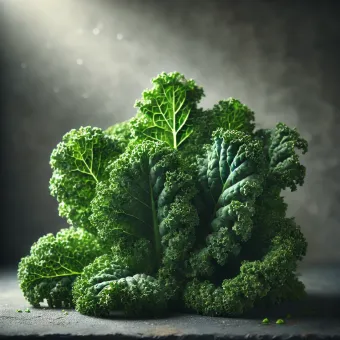Kale: 35 kcal, 389 µg Vitamin K & 93 mg Vitamin C per 100 g Raw
Curly or lacinato leaves pack fiber, carotenoids and sulphur-rich glucosinolates—earning kale its ‘nutrient powerhouse’ status.

What Is Kale?
A hardy **_Brassica oleracea_ var. *acephala*** leaf crop. Main market types: **curly, lacinato (dinosaur), red Russian, baby kale**.
Nutrition (100 g raw)
|Calories|Protein|Carbs|Fiber|Fat|Vit K|Vit C|
|---|---|---|---|---|---|---|
|35 kcal|2.9 g|4.4 g|4.1 g|0.5 g|389 µg (324 %)|93 mg (103 %)|
Benefits
- **Lutein, zeaxanthin & β-carotene** support eye & skin health.
- **Glucoraphanin → sulforaphane** (after chopping) shows detox & anti-inflammatory potential.
- Nearly 4 g fiber promotes fullness & gut microbiome diversity.
Drawbacks
- Very high vitamin K may interfere with warfarin—keep intake consistent.
- Raw kale contains **goitrogens**; steam or sauté if you have thyroid issues.
- Tough fibers can be chewy; massage with acid/oil or blend.
Flavour & Texture
Earthy-sweet with mild bitterness; curly leaves are fluffy, lacinato is tender & dimpled.
Culinary Uses & Storage
- **Massage** ribbons for salad, blitz into **green smoothie**, bake as **kale chips**.
- Add last minute to soup or sauté with garlic & lemon.
- Store unwashed bunch in perforated bag 0–4 °C up to 7 days; blanch-freeze 8 months.
- 1. Kale

